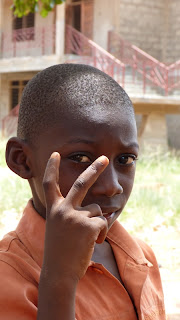Although we have been very busy working on our projects, we planned some weekend activities to explore Ghana. We took a trip to Cape Coast which is in the Western Region of Ghana, to see both the Elmina and Cape Coast castles and also to visit the Kakum National Park.
For those who are not familiar with the castles, here is a brief history taken from Wikipedia. Elmina castle is the largest and oldest of the castles built by Europeans in Ghana.
The Portuguese first reached what became known as the Gold Coast in 1471. Prince Henry the Navigator sent ships to explore the African coast in 1418. The Portuguese were attracted by rumors of
fertile African lands that were rich in gold and ivory.
These motives prompted the Portuguese to develop the Guinea trade.
They made gradual progress down the African coast and finally reached Elmina in 1471. At Elmina, they discovered a thriving gold
trade already established among the natives and visiting Arab and Berber
traders and the Portuguese established their own trading post, and it became known to
the Portuguese as “A Mina” (the Mine) because of the gold that could be
found there.
By the seventeenth century, most trade in West Africa was
the sale of slaves. The Elmina castle acted as a depot where slaves were bought in bartering
fashion from local African chiefs and kings. The slaves, often captured
in the African interior by the slave-catchers of coastal tribes, were
sold to Portuguese traders in exchange for goods such as textiles and horses.
The slaves were held captive in the castle before exiting through the
castle’s infamous “Door of No Return” to be transported and resold in
newly colonized Brazil and other Portuguese colonies.
 |
| Exterior of Elmina Castle |
|
|
In 1637 the fort was taken over by the Dutch who made it the capital of the Dutch Gold Coast.
During the period of Dutch control, they built a new, smaller fortress
on a nearby hill to protect St. George Castle from inland attacks. The Dutch continued the triangular Atlantic slave route until 1814, when they abolished the slave trade. In 1872 the British took over the Dutch territory.
It was a somber tour to hear the stories and see the place. There was a very strange smell in the rooms where the slaves were kept, and it is rumored that it is the smell of death.
We also, visited Cape Coast Castle, which was a 20 minute drive from Elmina and was built in 1637 by Swedish traders. It was a similar story to Elmina except smaller.
By the end of the day, we were tired and ready for a break from the sobering history. We went to a beautiful resort on the coast and relaxed.
The following morning, we went to visit Kakum National Park, which was about a 90 minute drive from the resort. Kakum is one of the most famous national parks in Ghana and is made up of mostly undisturbed rain forest. There is a canopy walk that has been built through the trees and is the major attraction at the park. There is also a nature walk, but the entire team decided to go on the canopy walk.
The walk was great for me, but not so great for those who were scared of heights. There canopy is made up of 7 bridges, and after the second bridge, you have to complete all 7. The bridges, become increasingly more crickety and swing a little more, so it could be a little nerve wracking at times, but it was mostly fun.
I have posted pictures below of the park and additional pictures from the castles. Overall it was a great weekend trip.
 |
| Elmina Castle |
 |
| Female dungeon at Elmina |
 |
| Tour guide at Elmina |
 |
| Cape Coast Beach |
 |
| Point of no return |
 |
| Dwight overcoming his fear of heights at Kakum |
 |
| Gary swinging from a tree at Kakum |





































